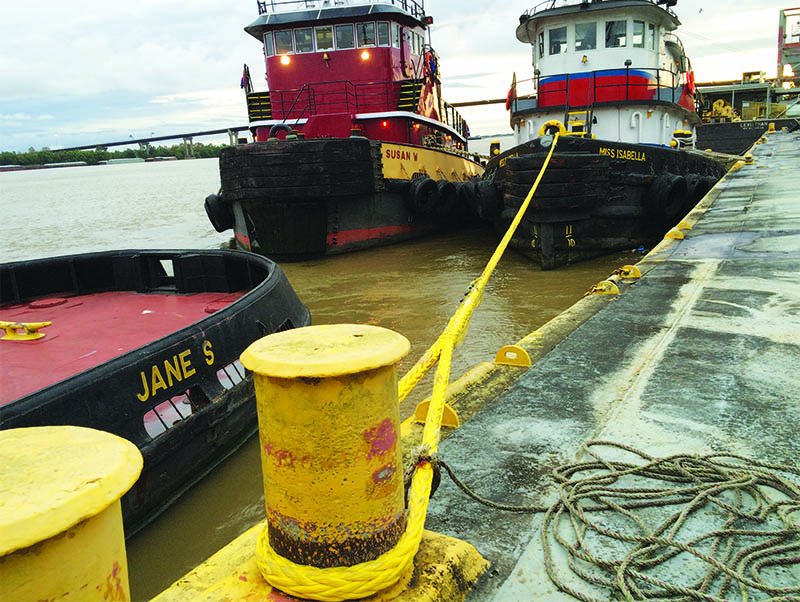Samson Rope recently introduced a couple of new synthetic towing lines, Fusion-12 and Quantum-X.
Fusion-12 is a 12-strand rope that’s a combination of Dyneema and polyester. “It allows to downsize line compared to 100 percent polyester,” said John Glaser, general sales manager at Samson Rope Technologies Inc., Ferndale, Wash. While the line might be downsized, the same load can still be pulled.
Quantum-X is a spin off of Samson’s Quantum-12. Quantum-X uses a new Dyneema base fiber, SK78, and Samson’s DPX yarn. The DPX is on the outer strands where it offers “a much higher coefficient of friction or grip,” said Glaser. Quantum-X also has a higher snag resistance. The line primarily is designed for bitts, capstans, and windlesses, though it can be used on a winch.
Both Quantum-X and Fusion-12 have a black stripe running down the rope’s axis. “That helps identify twist, something operators want to avoid,” said Glaser. If the line is parallel to the length of the rope, there’s no twist. A corkscrewing or spiraling line means there’s twist. That indicates some of the strands are doing most of the work. “It’s a significant strength loss,” noted Glaser.
Another company to come out with new towing ropes is India-based Garware-Wall Ropes Ltd. The X2 and the X2 Ultra were introduced first in Europe and Asia, and are now available in the U.S. The basic difference between the two is X2 Ultra is a sinking line, whereas the X2 is a floating line. The X2 is also used as a mooring line. Both the X2 and the X2 Ultra are billed as lighter and stronger than existing ropes.
“The key advantage for the X2 and X2 Ultra is it has the strongest weight-to-strength ratio,” said Garware-Wall’s Gopakumar Menon, who is based out of the company’s U.S. office in Tacoma, Wash.
In a thousand-cycle load limit (TCLL) test, Garware-Wall tested the X2 against Maxima, a line of blended polymers, and a polypropylene line. The polypropylene line failed after 1,267 cycles at 80% load, the Maxima after 1,251 cycles at 80%, and the X2 after 2,430 cycles at 80%.
“It’s almost like 100 percent more cycle loading,” said Menon. “That’s an important parameter for towing. The line will last longer.”
Replacing Wire
Companies such as Sampson and Garware-Wall are making inroads into the wire towing market. But towlines that have been around a while have had success too. One is Yale Cordage and its Ultrex, a 12-strand ultra-high molecular-weight polyethylene that’s been in use for the past 17 years.
“We are seeing a lot of river business growth replacing wire” with Ultrex line, said Jamie Goddard with Yale Cordage, Saco, Maine. “We are selling a lot of one-inch to one-and-a-half inch diameter.”
A lot comes down to “weight savings and flexibility of synthetic over steel cable.”
There can be weight savings of “at least eight times the weight of steel cable,” said Goddard, and line strength is not sacrificed. Plus synthetic line is much more flexible and easier to work with and it doesn’t rust or kink. Yale also helps customers develop chafe protection plans or come up with specific covers on the rope to make it abrasion resistant.

The Viking Cuff holds chafe guards in place. Fjord Inc. photo.
When compared to wire, synthetic line is soft, so it needs to be protected when passing across the hard surfaces of a chock or a tug’s bull nose. A chafe guard material that’s spliced or braided into the line protects the line from abrasion and wear. It’s installed by rope manufacturers and you often have to purchase a longer length than is needed, say 100' instead of 20'. But if you have some remnants of chafing material lying around, it’s possible that it could be put to use. That’s where the Viking Cuff from Fjord Inc.’s Chafe-Pro comes in.
With the Viking Cuff at the ends of the chafe guard, it grips the line and holds the chafe guard in place so it doesn’t move, said Michael Ratigan president of Fjord.
Send a 10', 20' or any length of chafe guard material to Fjord and Viking Cuffs will be added to it and “now you have a position able [chafe guard] for towing and assist operations,” said Ratigan. If that 10- or 20-foot length of chafe guard was spliced into a rope, it’s only good for that section of line, but when used with Viking Cuffs, the chafe guard can be slid up and down the line to wherever it’s needed.

This story originally appeared in the June 2017 issue of WorkBoat Magazine.




